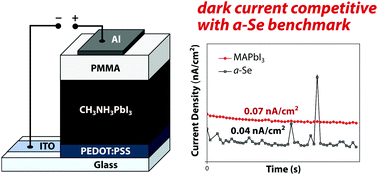
Paper published in J. Mater. Chem.
Direct conversion X-ray detectors with 70 pA/cm-2 dark currents coated from an alcohol-based perovskite ink
Yunlong Li, Emmanuel Adeagbo, Cyril Koughia, Blaine Simonson, Richard D. Pettipas, Anastasiia Mishchenko, Salman M. Arnab, Luc Laperrière, George Belev, Amy L. Stevens, Safa O. Kasap, and Timothy L. Kelly.
Direct conversion X-ray image detectors offer higher spatial resolution than their indirect counterparts. Organic–inorganic hybrid perovskites are among the most sensitive X-ray photoconductors for these detectors; however, high dark currents make it difficult for perovskites to compete with commercial amorphous selenium (a-Se) technology. Here we report a simple perovskite ink formulation that uses environmentally friendly 85% ethanol as the solvent. The ink was used to blade-coat thick perovskite films, which when combined with poly(methyl methacrylate) (PMMA) blocking layers, produce direct conversion detectors with dark currents ∼70 pA cm−2. These dark currents are two to three orders of magnitude lower than those of other perovskite-based detectors and are comparable to those of commercial a-Se devices. Other device figures-of-merit, including X-ray sensitivity and mobility-lifetime (μτ) product, are superior to those of commercial a-Se detectors. Our results demonstrate how to effectively suppress the dark current in perovskite photoconductive X-ray detectors, paving the way for low-dose mammography and radiography.

